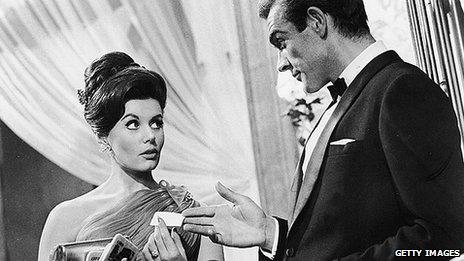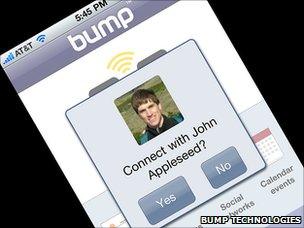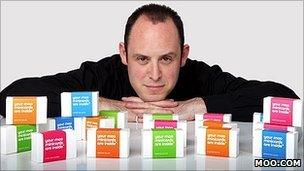Business cards side-lined by digital contact revolution
- Published

The name's Bond: Today's super-spies don't need to rely on having their business cards to hand to give a girl their number.
Industries may change and brand names may come and go, but at least one tradition in the business world has remained largely unchanged for hundreds of years.
The exchange of cards between two people who are meeting for the first time is a ritual that goes back as far as business itself.
For most of us, the handing over of contact details is an important moment - a clear signal that a connection has been made.
But as our lives turn increasingly digital, technology is attempting to provide a range of futuristic alternatives to the old-fashioned card.
Guess who I bumped into
Ever since the arrival of electronic communication, people have been exploring new ways to share information with each other- from swapping email addresses to trading mobile phone numbers and, increasingly, connecting through an online social network.
A range of services have appeared to take advantage of this trend, including Bump Technologies, a two-year-old startup based in California's Silicon Valley. Its application, which users download to their phones, lets people trade contact details simply by tapping their handsets together.
It is an approach that has a number of advantages over the traditional paper card, says Bump's Sadie Bascom - particularly since nobody goes anywhere without their mobile these days.
"It's easy, always on your phone, and you never have to remember to grab a stack of physical cards or worry about them running out."
It also gives users the chance to add directly to somebody's address book - skipping the need to enter those details by hand or saving people the chore of rifling through piles of cards to find the details they are looking for.
"People's dependence on their mobile devices to help them manage their lives is increasing," she adds. "Why take a few minutes to type someone into our phone when you can bump and save their info in a matter of seconds?
Potential goldmine

The Bump app lets you share details by tapping mobile phone handsets
Going digital has other advantages, too. Traders can include information that might be hard to fit on to a traditional business card, such as a portfolio or even a CV.
And for those who feel comfortable with the idea, forging a connection on Facebook or Twitter can prove a useful way to add personality to an otherwise sterile working relationship.
Given the explosive growth of the social websites over the past few years, some see this trend as a potential goldmine.
Investors including Sequoia - the venture capital group famous for backing Google, Oracle and PayPal - have pumped almost $20m into Bump, for example, in the hope that it can become a mainstream hit.
Meanwhile LinkedIn, the world's biggest business-centric social network, recently announced its plan to float on the stock market.
Analysts estimate that the launch will value the company, which lets people trade business contact information over the web, at around $175m.
Keeping it old school
While the trend to go completely digital might be growing, however, there is still a roaring trade in traditional cards. But even those are now getting a number of hi-tech overhauls.

Moo founder Richard Moross says a physical card conveys personality
Lower manufacturing costs mean that it is easier and cheaper than ever to make customised cards - leading some who want to stand out from the crowd to opt for innovative designs and materials such as aluminium and plastic that were previously too expensive to use.
London-based service Moo.com, meanwhile, has taken advantage of technology in a different way. Advanced digital printing techniques mean that Moo customers can use their own photographs to create a stack of hundreds of cards which each carry different, personalised images.
As a result the company, which now has customers worldwide and an office in the US, has built a strong following among creative professionals and technology-led businesses.
Richard Moross, Moo's founder and chief executive, says that this is because a physical card "conveys the card holder's personality through design".
"It's way more than just contact info," he says. "The more prevalent digital becomes, the more meaningful interacting is in the real world - analogue still rules at conferences and events. Using a digital business card can be a bit like talking on your phone at the dinner table."

Strict etiquette surrounds swapping meishi - or business cards - in Japan
Indeed, in some cultures, the role of the physical calling card is still hugely important.
While Americans might casually flip out a card from their wallet, for example, Japanese executives will carefully present their cards with both hands as a sign of respect.
But what is clear in almost every case, however, is that the advances in online networking mean the lines between professional and personal are becoming increasingly blurred.
The more information we share online through services like Facebook, Twitter and blogs, the bigger the idea of swapping contact details becomes - regardless of whether it's done physically or virtually.
"We have since seen a shift in the demographic as Bump gained popularity," says Sadie Bascom. "The majority of bumps now actually occur after 5pm, and our most used features are the photo sharing and messaging tools."